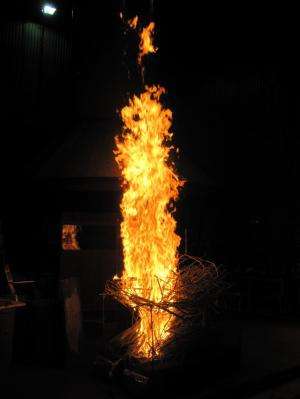Scientists uncover combustion mechanism to better predict warming by wildfires

Scientists have uncovered key attributes of so-called "brown carbon" from wildfires, airborne atmospheric particles that may have influenced current climate models that failed to take the material's warming effects into account. The work was described by a collaborative team of researchers from Los Alamos National Laboratory, Carnegie Mellon University and the University of Montana in the journal Nature Geosciences this week.
"Biomass burning and wildfires emit fine particulates that are toxic to humans and can warm or cool climate. While their toxicity is certain, their specific climatic effects remain unclear and are a hot research topic," said Manvendra Dubey, a senior Los Alamos climate scientist. "Smoke from wildfires accounts for one-third of the Earth's 'black' carbon—the familiar charred particles that are associated with fires with large flames. While black carbon is relatively simple—solely consisting of carbon—brown carbon contains a complex soup of organic material, making it difficult to identify, characterize and model."
Black carbon or soot that absorbs sunlight at all wavelengths is a well-known, potent warmer. Its twin, organic carbon co-emitted by fires, reflects sunlight and so can cool the climate. These two opposing effects cancel each other out, causing current climate models to predict that wildfires have a small net effect on climate. However, there is a third form of emission, called brown carbon, that absorbs sunlight at short blue wavelengths that is also in the soup of fire emissions.
The study discovered that brown carbon shares a common production mechanism with black carbon. Brown carbon's optical properties and volatility are highly variable and complex and no systematic treatment has been feasible in current models. In fact "what makes matters worse is many models treat brown carbon as organic carbon, a double whammy since they are computing a cooling effect for what is actually a warming particle," said Dubey. Clearly, he said, models could be significantly under-estimating warming effect of fires both now and in the future.
"You might call brown carbon frustrated black carbon that is made when the wood isn't fully cooked all the way," said Dubey. Brown carbon warms the atmosphere similarly to black carbon, but the actual prevalence of brown carbon in wildfire smoke has been a large question mark. This study should answer this by providing a simple treatment of all absorbing fire particles in models and improve climate predictions.
The Los Alamos team of Dubey, Allison Aiken and Shang Liu performed controlled laboratory experiments of the optical properties of particles emitted by globally important fuels. They carefully manipulated the particles by heating to remove the volatile components and then monitored changes in optical properties. Analysis revealed that the least volatile fraction, that is most likely to be transported globally similar to refractory black carbon, is much more light absorbing than the volatile fraction.
This finding clearly establishes the "global significance of brown carbon aerosol, a research area prioritized by DOE's Atmospheric System Research (ASR) program, and our discovery shows how this missing warming agent can be effectively treated in DOE's climate models" said Dubey.
The three-institution research team included both experimentalists and modelers who understand each other's languages and the experimentalists, know what the modelers need, and had this in mind for the experimental design, noted Rawad Saleh, a postdoctoral researcher at Carnegie Mellon and one of the leads on the study.
More information: Nature Geosciences , www.nature.com/ngeo/journal/va … t/full/ngeo2220.html
Journal information: Nature Geoscience
Provided by Los Alamos National Laboratory

















